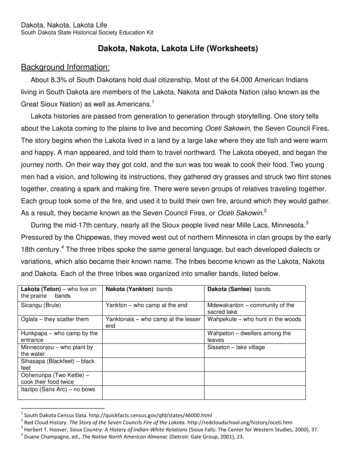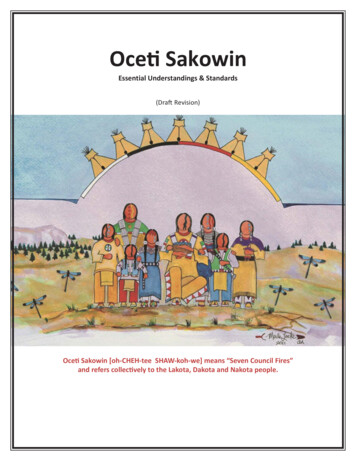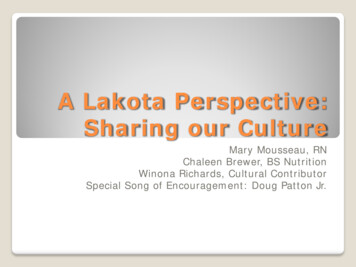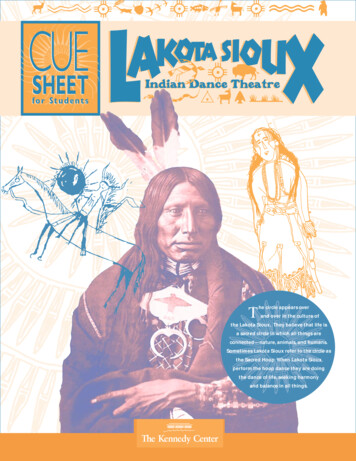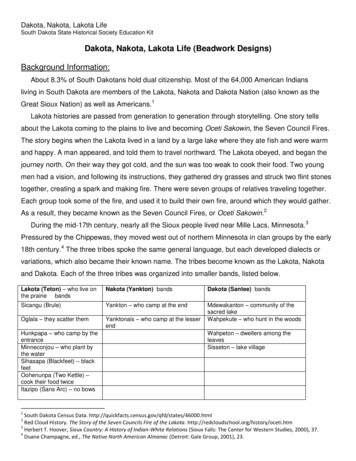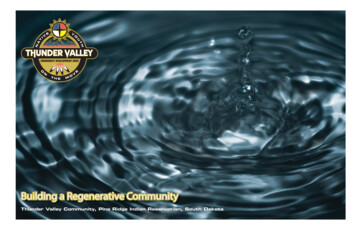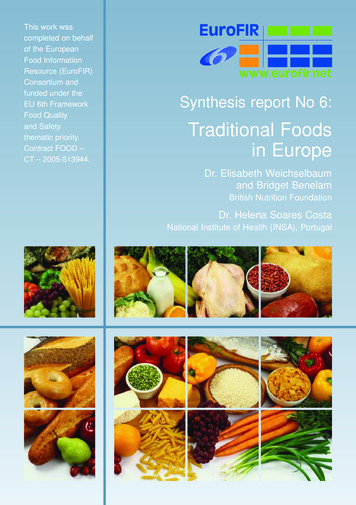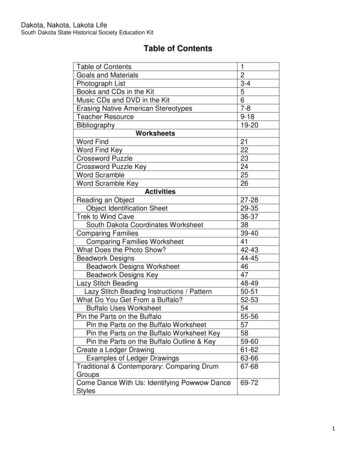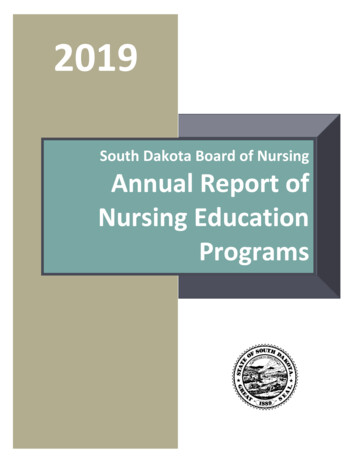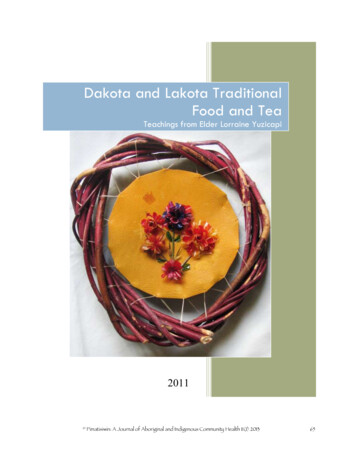
Transcription
Dakota and Lakota TraditionalFood and TeaTeachings from Elder Lorraine Yuzicapi2011 Pimatisiwin: A Journal of Aboriginal and Indigenous Community Health 11(1) 201365
66 Pimatisiwin: A Journal of Aboriginal and Indigenous Community Health 11(1) 2013Elder Lorraine YuzicapiFidji GendronRosella Bouch-van DusenAbstractElder Lorraine YuzicapiThe teachings in this booklet were gathered throughmeetings organized at Elder Lorraine Yuzicapi’s house inStanding Buffalo Dakota Nation during the summer of2010. Elder Lorraine, a knowledge keeper for StandingBuffalo Dakota Nation, gives workshops on traditionalfoods and teas across Canada and this booklet isdesigned to complement her workshops. Traditionaluses of mostly local foods and teas, their preservation,preparation and recipes are illustrated with severalpictures. Protein sources, such as fish, meats, andhazelnuts are described. The benefits of plants suchas corn, chives, prairie onions, wild turnips, biscuitcactus, cactus berries, sage, rose hips, and numerousother berries are presented. Medicinal, culinary, andceremonial properties of teas are described.Elder Lorraine lives on Standing BuffaloDakota Nation. Her father is Sisseton-Wahpeton. Her mother and grandmothers camefrom Wood Mountain Lakota Nation,Sitting Bulls’ tribe. The Sioux Nation is divided into seven sacred campfires and eachone has different ways of cooking,gatheringand preparing food. Elder Lorraine’s way isthe way of her mother and grandmothers.Out of her twelve brothers and sisters, onlyElder Lorraine and one of her sisters continue to practice the ways of their ancestors. She attributes her knowledge to listening to her mother and grandmothers.Key Words: Traditional uses of plants, medicinal plants,native prairie plants, health, nutrition, healthy lifestylesMartha Tawiyaka was Elder Lorraine’sgreat grandmother. Martha used to saythat all plants and animals serve manypurposes. Besides our physical well being,they provide medicines and all other needsfor survival. Elder Lorraine speaks aboutMartha Tawiyaka: “She was one hundredand seven when she died. I was happy tohave her as a grandmother and a teacher.”Elder Lorraine is passionate about manythings, including Traditional ways andAboriginal health. A major concern forher is the epidemic of diabetes and obesity that has struck First Nations andnon First Nations people alike. She is afirm believer in maintaining a healthydiet and exercise through preparation oftraditional foods, and using TraditionalMedicines to heal the body inside and out.Research contributions from the community: All information presented in this paper was shared by Elder Loraine Yuzicapi. The photograph on the first page is of fish scale art by Holly Yuzicapi, ElderLorraine’s daughter. We gratefully acknowledge the financial support of the Indigenous Peoples’ Health Research Centre. Most of thephotographs were taken at Elder Lorraine’s house during our meetings. All the photographs were taken by Fidji Gendron and RosellaBouch–van Dusen. This booklet was approved by Elder Lorraine.The teas and foods shown in this bookletcan be found in or near Standing BuffaloDakota Nation with the exception oflow bush cranberries and blueberrieswhich are from northern Saskatchewan,and blackberry tea from Ontario.
Dakota and Lakota Traditional Food and � 67FishThroughout the year different types of fishare caught. In the spring nets are used tocollect sucker fish. The same method is usedfor white fish in the fall. Jack and perch aremost often caught in winter. Pickerel arecaught all year. Trout that have been stockedin the lake are also available year round.Fish can be boiled, fried, baked, dried, orcooked over an open fire. The fish in theThe skin is left on the white fishphotos below are dried with cuts in theflesh to ensure they dry evenly. The fish arehung on a pole over a fire with pans underneath to catch the oil. The oil is used whenmaking pemmican. White fish are one ofthe fattiest fish. Once the fish are dried, theywill last for a long time. The fish can be keptlike this, or it can be made into pemmican.Fish or fish head soup will help stimulatemilk production in breastfeeding mothers.Dried white fish with cuts in the flesh
68 Pimatisiwin: A Journal of Aboriginal and Indigenous Community Health 11(1) 2013In addition to food, fish can be used in anumber of ways, such as tanning hides.After the fish are filleted, the guts andthe heads are boiled down in a mash.The mash is strained, soap and oil areadded, and the mixture is rubbed intothe hides to soften them during the tanning process. Anything that can not beused, such as the solids, are strainedScales before the dying processDyed scalesfrom the mash and buried with tobacco.Fish scales are used for art. The scales arecleaned, dyed, and then used with othernatural items, such as porcupine quills,red willow, and hide to make art. Theidea of using fish scales in art came fromChina, over 150 years ago, and was takenup by the Cree north of Fort McMurray.
Dakota and Lakota Traditional Food and � 69Flower design with fish scales on hide stretched with sinew around willowSome of the many uses of fish: dried fish, fish pemmican, fish scales, and fish scale art.
70 Pimatisiwin: A Journal of Aboriginal and Indigenous Community Health 11(1) 2013Waste is not a part of traditional foodpreparation. A story from Elder Lorraineabout waste during food preparation:Back then we did not have any flies because there was no waste. Look at thecity of Regina; it is called Pile of Bones. Allthose bones were left out from the buffalo to rot while they just took the hidesand left everything to rot. Then the fliescame. Once an animal is killed, almosteverything is used and whatever is notused is buried. It is just like fertilizer togive back to Mother Earth. Boiling an ani-mal’s bones does not mean we are poor;it means we are rich in the calcium andnutrients that the bones give off. Bonescan be used to add flavour. Lots of timeswe see people boiling the animal bones,and they will take a good drink becauseit has everything in there that you need.It is the same with our ceremonies, especially if a person is fasting. The firstthing that they will give them is a brothfrom the bones or the animal’s heartand tongue. It will give them strength.
Dakota and Lakota Traditional Food and � 71Other ProteinsDrying meatThere are many ways to dry meat, including: outside in the sun, over a fire, usinga smokehouse, or in a dehydrator. Whena fire is used outside, the meat is placedon poles, the fire is lit and plywood isplaced on two sides of the fire. The plywood acts as protection for the fire andkeeps the smoke and heat in which driesthe meat faster. The meat will dry in a dayto a day and a half in a food dehydrator.In a smoke house, it will be dry in about aday. An easy way to slice thin strips of meatis to start with the meat slightly frozen.There are many types of traditional proteinsElk jerky
72 Pimatisiwin: A Journal of Aboriginal and Indigenous Community Health 11(1) 2013Hazelnuts — Beaked Hazelnut (Corylus cornuta Marsh.)Hazelnuts are easy to find in the parkand coulees at Standing Buffalo DakotaNation. The nuts are picked off the bushesin late fall. Caution and gloves should beused as the outer covering of the hazel-Hazelnuts with sharp outer coveringnut shells is very sharp. Rubbing thehazelnuts between gloved hands removesthe sharp outer covering. The hazelnutshells are opened and the inner seedcan be ground and added to pemmican.
Dakota and Lakota Traditional Food and � 73Bulrushes — Cattail (Typha latifolia L.)CattailsIn the fall when the bulrushes are starting to turn colour, it is time to harvestthe stems. The stems are braided to makemats. The mats are used to keep out thecold and absorb the moisture from theground, which was very important in thepast because people lived on the ground.The cylindrical cattails are used as fillingto make pillows and mattresses. The bulbof the bulrush has a skin and beneath theskin is a pearly bulb. The bulb can be eatento cool the body down. Elder Lorrainesays: “it was like early air conditioning.”The bulb can also be dried to make flour.First Nations people live on the land, butthey have little control or say in what happens on neighbouring properties or whatis washed into the water. Between environmental change and the chemicals and pesticides that are commonly used, many nativespecies have declined, disappeared, or aretoo high risk from pollutants to eat. Manypeople do not want to use the bulbs fromthe bulrushes due to the risk of pollutants.Place mat made from bulrushes
74 Pimatisiwin: A Journal of Aboriginal and Indigenous Community Health 11(1) 2013CornCorn was adopted by the Dakota fromtribes that lived on the Missouri river.These tribes lived in large huts and didnot move with the seasons, so they wereable to maintain their crops. This method was not ideal for the Dakota becausethey traveled. Instead when the Dakotatraveled through an area they knew theywould revisit, they used deer horn to cultivate the ground and then spread theircorn. They would come back to theseareas in the fall and harvest the corn.Corn comes in many varieties, with manydifferent colours, shapes, and sizes. Eventhe small colourful corn can be used.Different varieties of cornSweet corn, or Taber corn, is boiled and driedon the cob. The water that has been used toboil ten to fifteen dozen corn can be strainedthen boiled down to make corn syrup.Sweet corn is boiled and dried on the cob
Dakota and Lakota Traditional Food and � 75Indian corn is not boiled. It is dried on thecob with the husks. The husks are braided together making ropes of corn that canthen be placed in the sun to dry. The cornmust be turned daily for seven or eightdays and the corn must be brought inif it rains. Indian corn can be made intosweet corn by boiling it before it is dried.Indian corn is dried in the sun with husksFrozen puffed corn can be added to soupTo remove the corn from the cobs, the drycorn is put in a sack and hit on the ground.Corn can be treated with lye, which is thelight part of the ash that is left from burning plain wood. The dark charcoal is notused. About four cups of lye are boiledwith six to eight cups of dry corn in a largepot for about one hour, then it is left to sitfor three or four hours. The corn will puffup like popcorn.This puffed cornmust be thoroughly washed. It canbe frozen for lateruse or put directlyinto soup. Driedor puffed corn canbe used in soup.
76 Pimatisiwin: A Journal of Aboriginal and Indigenous Community Health 11(1) 2013The husks from the corn canbe used to make corn huskdolls. Empty cobs of corncan be used like a brush,which when used with flourscrub and clean light coloured leather. One teaspoonof dried and chopped cornsilk soaked in a large cup ofwater can be drunk on a dailybasis to help with weightloss and for healthy skin.Corn silkDry cornBoth Indian and sweet corncan be pounded into flour. Ifit is dried in the oven it is easier to pound. Once browned,the corn can be ground toa fine powder in a mixer. Crushed chokecherries, saskatoons, or other berries canbe added to the corn flour with a sweetener, and lard. The mixture will firm up in therefrigerator into corn balls. Dried meatscan be added. Whenmade with meatsand berries, the cornballs have everythingneeded for a wholemeal. Oil can be added to the flour, berries, and meat to makea granola-like snack.
Dakota and Lakota Traditional Food and � 77Chives — (Allium schoenoprasum L. var. sibiricum [L.] Hartm.)Dried chive flowersFresh chives
78 Pimatisiwin: A Journal of Aboriginal and Indigenous Community Health 11(1) 2013Onions — Prairie Onion (Allium textile Nels. and Macbr.)Dried onions in the groundWhen green, the whole onion can be used.Onions can also be dried and stored forlater use. The longer onion and chives are inDried onionsthe ground, the more intense their flavourgets. Once they flower, they are quite bitter.
Dakota and Lakota Traditional Food and � 79Wild turnips — Indian breadroot (Psoralea esculenta Pursh)Wild turnips are dug up between themiddle of June and the middle of July, depending on the weather. They should bepicked right away because if they are lefttoo long, the centre will become woody,they will be brown, and there will be astem in the turnip. Once dug up, theyhave a thick peel which must be removed.They can be frozen or dried. When dryingthe plant a long stem is left on the turnipso that they can be braided and hung outside. They can be dried in a dehydrator.Some people prefer to grate them beforedrying. Turnips can be ground into flour.Dried wild turnipsAbove ground portion of the plantWild turnips with the outer peel.
80 Pimatisiwin: A Journal of Aboriginal and Indigenous Community Health 11(1) 2013Wild mushroomsDried mushroomsDried mushrooms can be madeinto soup with wild rice and driedmeat. The dried meat is broken intosmall chunks and boiled until it puffsup. Cooked rice, a flour sauce, mushrooms, and chives are added to the soup.Biscuit cactus - Prickly-pear cactus (Opuntia polyacantha Haw.)The biscuits can be cut off thenblanched to remove the outer skin.The inner portion can be covered withbrown sugar and baked in the oven.Biscuit cactus in bloom
Dakota and Lakota Traditional Food and � 81Cactus berries — Pincushion cactus (Mamillaria vivipara (Nutt.)Haw.)Berries will form on the cacti afterthey have flowered in August. The cactus berries can be used to make a jam.CactusCactus in flower
82 Pimatisiwin: A Journal of Aboriginal and Indigenous Community Health 11(1) 2013Sage — Prairie sage (Artemisia ludoviciana Nutt.)Sage can be cut into fine powderand used for smudge. Using an electric grinder makes the sage fluffy.This is a process that must be done byhand, a lesson in patience. A teaspoonof this smudge will go a long way.Dried sageWomen on their time should smudgewith sage instead of sweet grass. Whena woman finishes her moontime, sheshould take a sage bath. Sage is boiledin about a gallon of water before being added to the bath. When the sage isprepared for a bath, some of the preparation can be drank to cleanse the bodyinternally. After shampooing, sage watercan be used as a rinse or combed intothe hair. It stimulates the pores and thescalp. It is also good for the skin. Sagecan be used as a treatment for diarrhea.Prairie sage
Dakota and Lakota Traditional Food and � 83Rose hips — Prickly rose (Rosa acicularis Lindl.)Dried rosehips store wellRose hips are picked any time throughoutthe winter; however, it is best to pick themfresh, around late September. They may bemade into medicine or dried for storage.Prickly roses in flower
84 Pimatisiwin: A Journal of Aboriginal and Indigenous Community Health 11(1) 2013Whole dried rose hips are ground in a blender and the seeds are removed. The powdercan be used to make custard or pudding.Rose hip berries have considerableamounts of vitamin C. To use rose hips asa vitamin supplement, make the followingmixture. Rehydrate some of the whole rosehips in steam or a small amount of boiledwater. Dry them off with a tea towel. Nextmix them with hot lard and sweetener.Mash the entire mixture, including seeds,and put it in a pint sealer. Every morningtake about a tea spoon of it. Chew the mixture really well because it cleans the entiredigestive tract. When it is going throughthe rectum, it prevents hemorroids. Donot eat more than one tea spoon andchew the seeds. If too much of the mixtureis ingested, it will cause an itchy rectum.BerriesMost berries can be used to make jams,jellies and tea. They can also be dried andadded to pemmican or mixed with corn.If the berries are dry enough they can beground like hazelnuts and added to pemmican. Many fruits have their own pectinfor making jams which eliminates or limitsthe amount of pectin that has to be added.Black currants — Wild black currant (Ribes americanum Mill.)Black currants are found alonglakes and in watery areas. Theyare picked in July and August.Black currants
Dakota and Lakota Traditional Food and � 85Gooseberry — (Ribes oxyacanthoides L.)Like black currants, gooseberries growalong the water ways and creeks. They areharvested in July and August. Dry goose-berries can be mixed into pemmican withcorn and meat. A granola is made fromgooseberry, dry corn, raw sugar, and fat.Raspberry — (Rubus idaeus L. var. strigosus (Michx.) Maxim.)Raspberries can be used to helpease pain, fever, and inflammation.Ripe raspberriesStrawberry — (Fragaria glauca [S.Wats.] Rydb.)Strawberries are ready to be harvestedin June-July.Wild strawberries
86 Pimatisiwin: A Journal of Aboriginal and Indigenous Community Health 11(1) 2013Saskatoon Berries — (Amelanchier alnifolia Nutt.)Saskatoons can be frozen or dried.They make delicious tea, jam, and jelly.Saskatoon bush in flowerDried saskatoon berries
Dakota and Lakota Traditional Food and � 87Saskatoon berriesBlueberry — (Vaccinium myrtilloides Michx.)Blueberries are found in northern Saskatchewan.
88 Pimatisiwin: A Journal of Aboriginal and Indigenous Community Health 11(1) 2013Chokecherry — (Prunus virginiana L.)Chokecherry juice is a blood cleanser, whichrevitalizes the blood, and gives energy. Thisis why it is given to people who have beenfasting for Sun Dances. Chokecherry juice ismade just before it is needed from fresh orfrozen chokecherries. To make juice chokecherries are boiled, a sweetener is added,and the mixture is allowed to cool. As soonas it is cooled, it is mashed, strained, andplaced in containers. The strained solids canChokecherries ready to be harvestedChokecherry patties that have been driednot be reused because of the chokecherryseeds, so they are buried with tobacco.Chokecherries can be dried in patties. Thechokecherries are ground, seeds and all,flour and water are added, the mixture isshaped into patties, and dried. Some peopleeat the patties like this, but the patties can bereconstituted and cooked in lard. The flourand lard are used because the chokecherries on their own can cause constipation.
Dakota and Lakota Traditional Food and � 89Buffaloberry — Silver buffaloberry (Shepherdia argentea Nutt.)Buffaloberries are picked late in the fallwhen they are very juicy. In October orNovember, when the berries are frosted,tarps are placed under the trees. The treesare hit with sticks, and the berries fall intothe tarps. The berries are cleaned and frozen. They can be used to make relish. Tomake cowboy relish, put the berries inwater to rehydrate them. Once they aremoist, put them in a blender with raw sugar, chopped apples, and cinnamon. The relish can be eaten immediately, or preserved,by adding fruit pectin and putting it in jars.It is used like cucumber relish with meats.Fresh buffaloberries can also be madeinto patties. If they are very juicy, turnip or any kind of flour can be added.Dried buffaloberry pattiesLow bush cranberry — (Viburnum edule [Michx.] Raf.)Low bush cranberries are not found nearStanding Buffalo Dakota Nation but innorthern Saskatchewan. Cranberry juicecleans the pancreas and kidneys. Save thepulp to make a sauce or freeze whateveris left over. It can be used in cowboy relish. Put the pulp in a blender with lotsof sugar, as they are very tart. If they arecanned for jelly, they have their own pectinand very little pectin needs to be added.Dried cranberries
90 Pimatisiwin: A Journal of Aboriginal and Indigenous Community Health 11(1) 2013TeaDifferent berries, along with theirleaves and stems, can be used for tea.Again, there is no waste. After drink-ing the tea, chew and eat the berries,leaves, and stems to cleanse the esophagus, stomach and revitalizes the blood.Berry teaDried saskatoon berries and stems are used as teaLeaves, stems, and berries from strawberries,saskatoons, raspberries, blueberries, andmany other types of berries can be used fortea. The tea will ease pain. When combinedwith other ingredients, the tea can be usedto cleanse and lower blood sugar. The darker berries help cleanse the blood. They alsohave antioxidants for cancer prevention.Red clover — (Trifolium pratense L.)Red clover tea made from just the leavesand stems, no flowers, helps to stop internal bleeding. Red clover cleanses theuterus after giving birth. It can be used ifbleeding continues for some time. A teamade of a mixture of red clover and otherroots can be used to stop a woman’s timeuntil the next cycle, allowing her to attend ceremonies. Red clover often growsalong fence lines, but it can be hard tofind. The tea is not drunk every day, butintake is based on your health condition.
Dakota and Lakota Traditional Food and � 91Red clover teaThorn berry — Hawthorn (Crataegus spp. L.)Thorn berry bushes are grey, with longthorns, and orange berries. The driedberries, stems, and leaves are used forDried thorn berriesheart conditions. Thorn berry tea cleanses the blood and opens the arteries.
92 Pimatisiwin: A Journal of Aboriginal and Indigenous Community Health 11(1) 2013CedarDried cedarCedarCedar leaves areused to cool downthe body. It can bedrunk when it is hotoutside, or someone has a fever.If it is boiled quitestrong, with someof the stems, it actsas a liniment to relieve sore musclesand aching bones.
Dakota and Lakota Traditional Food and � 93Mint — (Mentha arvensis L.)Mint can be found insloughs and waterways. It is best pickeduntil mid August,as once it flowersit becomes bitter.Mint leaves and stemsFresh mintare used to helpprevent colds andstrengthen the blood.Mint hung to dry
94 Pimatisiwin: A Journal of Aboriginal and Indigenous Community Health 11(1) 2013Dandelion — (Taraxacum officinale Weber)Dandelion in flowerDandelion tea made from the stems andleaves, not the flowers or roots, makes agood liver cleanser. Dandelion roots areeasier to pick when the ground is soft. Theroots can be broken off, washed really well,and then dried. Dandelions can be usedin salad by soaking them in cold water fortwo or three hours, before tearing theminto a salad. Inside the stems, there iswhite milk, which works as a topical treatment for warts; strong dandelion tea canbe swabbed onto warts as a treatment. Theflowers are used for dandelion wine. Theroots can be used as a coffee, which willcleanse the body and remove caffeine. Tomake the coffee, grind up dried dandelionroots, cover with water that has come to afull boil, and then steep for five minutes.
Dakota and Lakota Traditional Food and � 95Yarrow — (Achillea millefolium L.)Yarrow helps the immune system andthe root and tied together in a bunch toprevents colds. In July, the flowers aredry. The roots can be used, but it is alpicked whole. They are broken off atways good to leave the roots, to encourage a plentiful supply in the future.YarrowYarrow flowerBlackberry teaBlackberries can not be found onor near Standing Buffalo DakotaNation. The tea in this image wastraded with an Ojibwa Grandmother.Tea made from blackberry leavesand stems strengthens the eyes.Blackberry tea can be used every day.Blackberry tea
96 Pimatisiwin: A Journal of Aboriginal and Indigenous Community Health 11(1) 2013ToolsElder Lorraine uses crushing rocks to grindsome of her berries and foods. Her crushing rocks, which come from the WoodMountain hills, were ground down overtime. The rock can be gripped or a freshcherry stick can be wrapped around therock as a handle. The rocks can be used foreverything from berries to corn. The item tobe crushed is wrapped in cloth and pounded until it reaches the desired consistency.Elder Lorraine’s crushing rocksElder Lorraine showing that items are crushed wrapped in cloth
Dakota and Lakota Traditional Food and � 97Elder Lorraine Yuzicapi is a knowledge keeperon Standing Buffalo Dakota Nation. She is passionate about many things, including Traditionalways and Aboriginal health. A major concern forher is the epidemic of diabetes and obesity thathas struck First Nations and non First Nationspeople alike. She is a firm believer in maintaininga healthy diet and exercise through preparation oftraditional foods, and using Traditional Medicinesto heal the body inside and out. Elder Lorrainegives workshops on traditional foods and teasacross Canada and this booklet was designed tosupport her workshops.Dr. Fidji Gendron is an Associate Professor atthe First Nations University of Canada in Regina,Saskatchewan. She is interested in traditional usesof native plants. She works in partnership withElders and has developed several booklets on plantmedicines. Dr. Gendron and Mrs Bouch-van Dusenspent several hours at Elder Lorraine’s house totalk about the information contained in this booklet. Elder Loraine has commented and agreed onthe information and the format of the booklet.fgendron@fnuniv.caRosella Bouch-van Dusen just received herBachelor of Health Studies at the University ofRegina. She has worked on several projects relatedto Aboriginal health and is interested in learningmore by spending time with Elders.
Jul 06, 2013 · from Wood Mountain Lakota Nation, Sitting Bulls’ tribe. The Sioux Nation is div - ided into seven sacred campfires and each one has different ways of cooking,gathering and preparing food. Elder Lorraine’s way is the way of her mother and grandmothers. Out of her twelve brothers and
